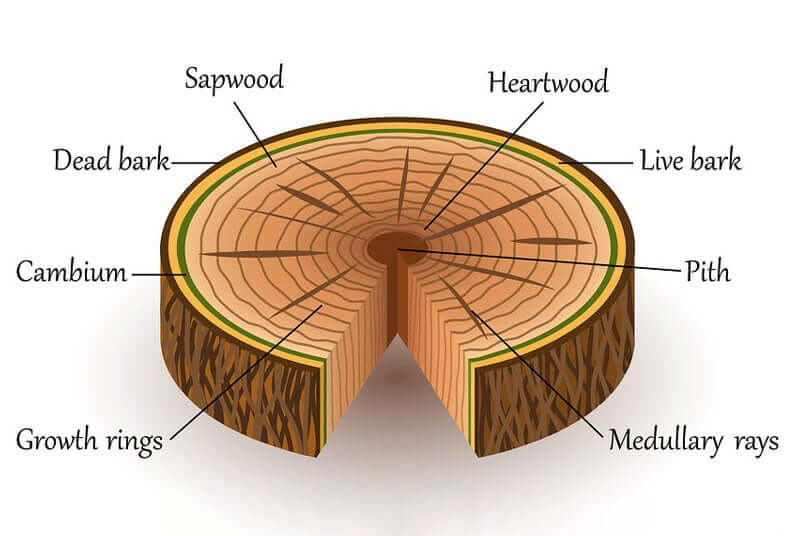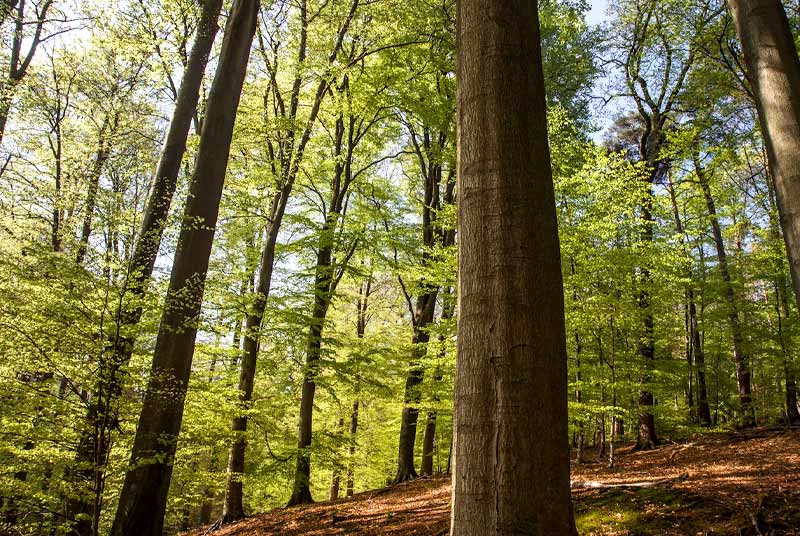Our team has previously shared basic details on the components and structure of a tree. Hence, in this piece, I’ll skip the general discussion on tree structure to directly delve into the trunk and its elements.
The trunk is the vertical part of the tree that connects the tree to the tree’s roots and provides support to the tree crown. It also serves to transport nutrients, material, and water between the root system and crown to keep the tree healthy.
The tree trunks consist of several basic parts:
- Pith
- Heartwood
- Sapwood
- Cambium layer
- Phloem (inner bark)
- Outer bark (outer layer)
- Growth rings
- Medullary ray (wood ray)
Let’s peel off the trunk…
What we cover
ToggleParts of a tree trunk
The trunk, aka main steam, is composed of several layers that all work together. This is the main difference that separates evergreen and deciduous trees from plants. The trunk1 makes up the majority of the tree structure at 60%.
The main purpose of the trunk is to raise the leaves above the ground, enabling the tree to reach the sunlight and survive. Although it looks pretty straightforward, the biology of the trunk is very complex. It is a constantly growing organ.

Here are the main parts of the trunk and their anatomy and functions:
Pith
Pith is the initial provider of nutrients for the sapling and the center of the trunk. Pith, aka medulla, is a tissue in the stems of vascular plants. It is composed of soft, spongy parenchyma cells, which store and transport water and nutrients through the plant. It is the innermost layer which also helps to keep trees healthy.
Heartwood
Heartwood is the heaviest, and the dentist part of the trunk with the darkest color. The xylem cells of the heartwood function chiefly to give strength and support to the tree and it is also an essential part of the tree physiology because it is a storage for sugars, dyes, and oils.
Sapwood
Cambium
An outer growth layer creates both sapwood and phloem, which increases the thickness of the whole tree. In climates with distinct seasons, the tree adds a new cambium layer each growing season.
This expands the trunk and produces annual rings, which can be interpreted from coring or felling to determine the tree’s age.
The anatomy of a palm trunk is very different from a regular tree. There is no heartwood or bark, just cambium and phloem throughout.
Phloem (inner bark)
After the cambium, the next layer is the phloem, aka inner bark. Its purpose is to move sap that has been transformed from leaf photosynthesis and contains sugar, around the tree and back down to the roots.
Bark
The bark is the outermost layer that is the first line of defense and protection of the tree. All dead phloem cells that are shed outward, are forming the bark.
The bark performs multiple functions such as tree insulation from excessive heat, which may include fire resistance or cold, and provides protection against insects and diseases.
The bark is not a uniform creation. It can be thin or up to 6 inches thick, with variable color, the surface may range from smooth to deeply furrowed, and may contain tannins. Bark characteristics2 are key to tree identification.
Growth rings
With every new year, the tree gets a new ring of sapwood that is visible.
Wood ray (medullary ray)
Wood rays represent the living cells that run across the growth rings that allow the transportation of the sap radially.
Functions of a tree trunk
There are two main functions of the tree’s trunk. Giving the size and shape of the tree is the first job of the trunk. It is the foundation of strength that provides structural support to the tree for its branches and leaves to grow upward and outward.
The second function of the trunk is to act as the hub of the transport system. When water and minerals go up from the root system in the soil to the branches, stems, and eventually to the leaves, the tree trunk facilitates the movement. It has the same role when sugar moves down from the leaves, stems, and branches to the roots.

FAQ's
Stems are directly attached to the leaves and don’t have surrounding bark while on the other side, the trunk isn’t directly connected to the leaves and has a coat of outer bark.
In general, a tree trunk is a “single stem”, but can be multiple-stemmed, with the same function as a single stem, materials transport, and support.
The point where two branches or stems join or where a branch meets a trunk is called branch union.
In short, a trunk is the main development area where major development happens, while all the branches are sub-development areas where different functions happen.
- Arbor Day Foundation, (2019) Anatomy of a Tree. <https://www.arborday.org/trees/treeguide/anatomy.cfm> Accessed: 20-02-2024.
- Anine Krantz and Mary Tebo Davis, (2019) Bark! A Great Way to Identify Trees in the Winter. <https://extension.unh.edu/blog/2019/03/bark-great-way-identify-trees-winter> Accessed: 20-02-2024.
- Michael Snyder, (2007) What Is the Difference Between Sapwood and Heartwood? <https://northernwoodlands.org/articles/article/what_is_the_difference_between_sapwood_and_heartwood> Accessed: 20-02-2024.



